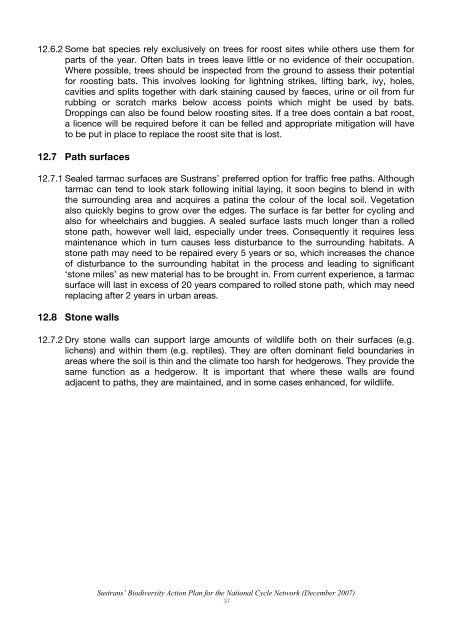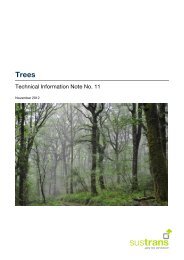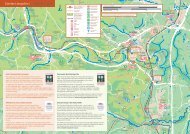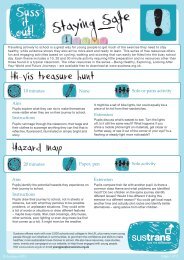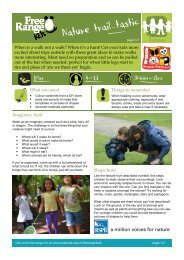Biodiversity Action Plan for the National Cycle Network ... - Sustrans
Biodiversity Action Plan for the National Cycle Network ... - Sustrans
Biodiversity Action Plan for the National Cycle Network ... - Sustrans
You also want an ePaper? Increase the reach of your titles
YUMPU automatically turns print PDFs into web optimized ePapers that Google loves.
12.6.2 Some bat species rely exclusively on trees <strong>for</strong> roost sites while o<strong>the</strong>rs use <strong>the</strong>m <strong>for</strong><br />
parts of <strong>the</strong> year. Often bats in trees leave little or no evidence of <strong>the</strong>ir occupation.<br />
Where possible, trees should be inspected from <strong>the</strong> ground to assess <strong>the</strong>ir potential<br />
<strong>for</strong> roosting bats. This involves looking <strong>for</strong> lightning strikes, lifting bark, ivy, holes,<br />
cavities and splits toge<strong>the</strong>r with dark staining caused by faeces, urine or oil from fur<br />
rubbing or scratch marks below access points which might be used by bats.<br />
Droppings can also be found below roosting sites. If a tree does contain a bat roost,<br />
a licence will be required be<strong>for</strong>e it can be felled and appropriate mitigation will have<br />
to be put in place to replace <strong>the</strong> roost site that is lost.<br />
12.7 Path surfaces<br />
12.7.1 Sealed tarmac surfaces are <strong>Sustrans</strong>’ preferred option <strong>for</strong> traffic free paths. Although<br />
tarmac can tend to look stark following initial laying, it soon begins to blend in with<br />
<strong>the</strong> surrounding area and acquires a patina <strong>the</strong> colour of <strong>the</strong> local soil. Vegetation<br />
also quickly begins to grow over <strong>the</strong> edges. The surface is far better <strong>for</strong> cycling and<br />
also <strong>for</strong> wheelchairs and buggies. A sealed surface lasts much longer than a rolled<br />
stone path, however well laid, especially under trees. Consequently it requires less<br />
maintenance which in turn causes less disturbance to <strong>the</strong> surrounding habitats. A<br />
stone path may need to be repaired every 5 years or so, which increases <strong>the</strong> chance<br />
of disturbance to <strong>the</strong> surrounding habitat in <strong>the</strong> process and leading to significant<br />
‘stone miles’ as new material has to be brought in. From current experience, a tarmac<br />
surface will last in excess of 20 years compared to rolled stone path, which may need<br />
replacing after 2 years in urban areas.<br />
12.8 Stone walls<br />
12.7.2 Dry stone walls can support large amounts of wildlife both on <strong>the</strong>ir surfaces (e.g.<br />
lichens) and within <strong>the</strong>m (e.g. reptiles). They are often dominant field boundaries in<br />
areas where <strong>the</strong> soil is thin and <strong>the</strong> climate too harsh <strong>for</strong> hedgerows. They provide <strong>the</strong><br />
same function as a hedgerow. It is important that where <strong>the</strong>se walls are found<br />
adjacent to paths, <strong>the</strong>y are maintained, and in some cases enhanced, <strong>for</strong> wildlife.<br />
<strong>Sustrans</strong>’ <strong>Biodiversity</strong> <strong>Action</strong> <strong>Plan</strong> <strong>for</strong> <strong>the</strong> <strong>National</strong> <strong>Cycle</strong> <strong>Network</strong> (December 2007)<br />
37


